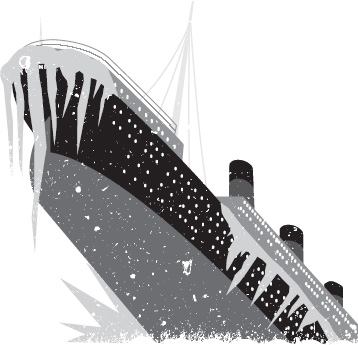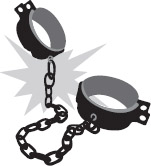Uncle John’s Bathroom Reader Zipper Accidents (41 page)
Read Uncle John’s Bathroom Reader Zipper Accidents Online
Authors: Uncle John’s



•
“Titanic reminds me of the days I had two yachts in Miami,” he wrote, “but no icicles.”
C
HOKING HAZARD
Millions of cute animals got an unwanted oil bath, all because Captain Joe Hazelwood got drunk and went to bed. Yet was the 1989 Exxon
Valdez
oil spill really caused by a lone drunk man? That’s what the Exxon Shipping Company’s lawyers argued. In court, Hazelwood admitted that in the hours preceding the accident, he and a few other officers had had a few vodkas in the town of Valdez, Alaska, where the ship had been docked. By the time they arrived back onboard that evening, Hazelwood claimed, he was sober. He took command, and the 986-foot tanker carrying 53 million gallons of crude oil departed for California. After being guided out of the Narrows by a tugboat, the
Valdez
had to navigate its way out of the rocky Prince William Sound. Captain Hazelwood had successfully performed this maneuver many times.
MIDNIGHT OIL
It was a “dark and misty” night, and the ship’s sonar had picked up ice floating on the surface. Hazelwood plotted a new course outside of the regular shipping lanes to avoid the ice. He then asked Third Mate Greg Cousins, “Do you feel comfortable enough that I can go below and get
rid of some paperwork?” Cousins said he was. He was authorized to take command of the ship in open waters, but he did not have a license to pilot the ship in difficult Prince William Sound. But Hazelwood had confidence in him. So he went to his cabin to “sleep off his bender,” as newspapers would later report. Cousins took control and spouted off orders to helmsman Robert Kagan, who was on his first ocean voyage in four years.
There was more ice on the water than Cousins expected and, according to Kagan, at one point Cousins became “panicked” and ordered Kagan to take a hard right. Kagan refused. Cousins then tried to take the wheel himself. Kagan refused to let him. Barely 10 minutes after he got to his cabin, Hazelwood received a call from Cousins: “We’re getting into serious trouble here.”
“Where’s the rudder?” asked Hazelwood. But before Cousins could answer, at 12:04 a.m. on March 24, 1989, the Exxon
Valdez
ran aground on an underwater rock formation called Bligh Reef. Hazelwood hung up and ran to the bridge. He took the helm and tried to free the ship from the jagged rocks. He made the problem worse. Within a few hours, eight of the ship’s 11 cargo tanks had ruptured, and about 11 million gallons of crude had gushed out into the sea.
YOU’RE SOAKING IN IT
As the spill made international headlines, Captain Hazelwood became the scapegoat. News programs showed globules of crude oil washing
up along 1,300 miles of Alaska’s pristine southern coastline. It covered everything it came in contact with— orcas, herring, salmon, seals, birds, otters, clams, even plankton. To this day, crude oil from the
Valdez
can be found in Prince William Sound, and the region’s tourism and fishing industry never completely rebounded. The
Valdez
accident wasn’t even in the top 50 spills in terms of the amount of oil lost, but it has become one of the most infamous manmade disasters of all time.
“THE COMPANY’S LAWYERS’ MAIN ARGUMENT: EXXON DIDN’T DO IT ON PURPOSE, SO IT SHOULDN’T BE PUNISHED AS IF IT DID.”
DISORDER IN THE COURT
A judge initially fined the company $5 billion, equal to one year’s profits. Exxon appealed and got the amount reduced. Then it appealed again… and again—each time getting the amount whittled down even more. The company’s lawyers’ two main arguments: 1) Exxon didn’t do it on purpose, so it shouldn’t be punished as if it did; and 2) If Captain Hazelwood hadn’t gotten drunk and left the bridge, the ship wouldn’t have crashed.
Exxon took the case all the way to the U.S. Supreme Court. In 2008 eight of the nine judges heard oral arguments. (Justice Samuel Alito recused himself because he owns Exxon stock.) The court’s ruling: Exxon’s actions were “worse than negligent but less than malicious.” They reduced the punitive
damages from $2.5 billion to $500 million.
Third Mate Greg Cousins was cleared of all charges. Captain Hazelwood was acquitted of felony charges but found guilty of a misdemeanor “negligent discharge of oil.” He was fined $50,000 and sentenced to 1,000 hours of community service. He never captained a ship again.
UNSOUND POLICIES
According to BBC journalist Greg Palast, who spent much of the 1990s investigating the accident, executives at Exxon, British Petroleum, and other oil companies were to blame, as they knew of the risks of a spill in Prince William Sound. After all, that’s where the Alaska Pipeline lets out, and it would have been far too costly to move operations to a less fragile area. So for more than a decade, charged Palast, the companies falsified records, threatened whistleblowers with blackmail, and cut safety costs.


Here’s the worst part: The
Valdez
disaster could have been prevented by a piece of radar-repeating equipment called the RAYCAS (Raytheon Collision Avoidance System). Unlike the ship’s sonar, the RAYCAS could detect objects underwater. “The third mate,” said Palast, “would never have hit Bligh Reef had he simply looked at his RAYCAS radar. But he could not. Why? Because it was not turned on. The complex system costs a lot to operate, so frugal Exxon management left it broken and useless.”
P
hillip Seaton of Waddy, Kentucky, had gone to the hospital in 2007 to be circumcised, in order to better treat an inflammatory problem. During the procedure, however, Seaton’s physician, Dr. John Patterson, discovered that Seaton’s penis was, as he later testified, “riddled with cancer.” So what did Dr. Patterson do? He lopped it off.


When Seaton came to, he was, reasonably, very upset to find out that his penis was gone, and had been removed without his consent. He sued Dr. Patterson, claiming that he never gave permission to have his penis cut off and was not given the opportunity to get a second opinion.
“This case isn’t about a man’s penis being removed,” Dr. Patterson’s lawyer said in court, “it’s about cancer being removed.” Seaton’s lawyer argued that his client should have had the opportunity to treat the cancer in such a way that it require the lopping off of his penis.
The judge initially sided with the doctor; the case is currently under appeal. But no matter what happens, or however much money Seaton gets in a settlement, he’ll never get his penis back. But he doesn’t have cancer, which is nice.
READER CLASSIC SERIES
Find these and other great titles from the Uncle John’s Bathroom
Reader Classic Series at
www.bathroomreader.com
.
Or contact us at:
Bathroom Readers’ Institute
P.O. Box 1117
Ashland, OR 97520
(888) 488-4642

